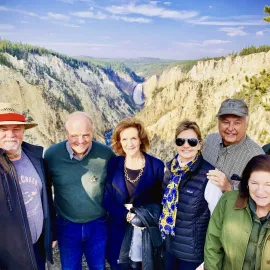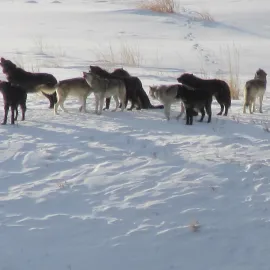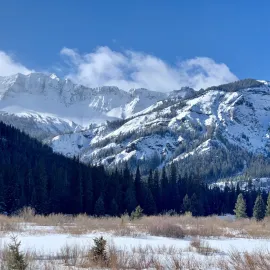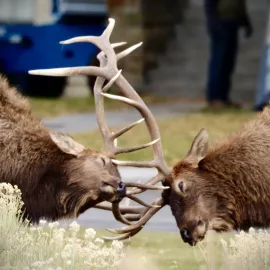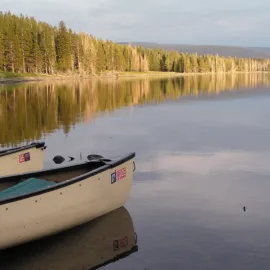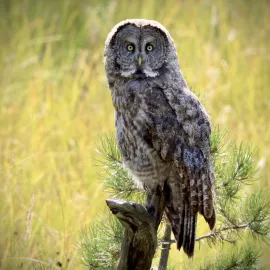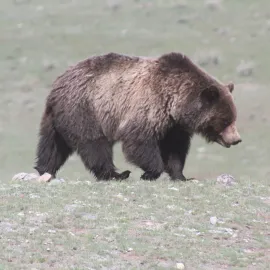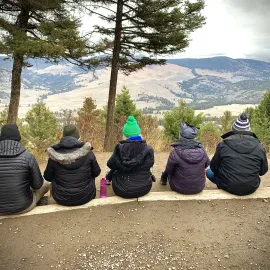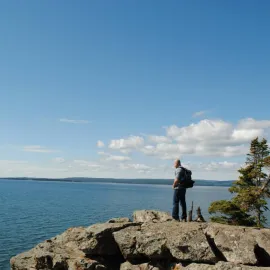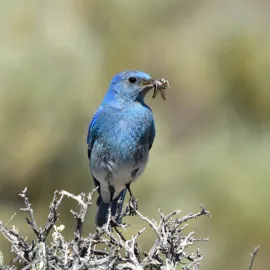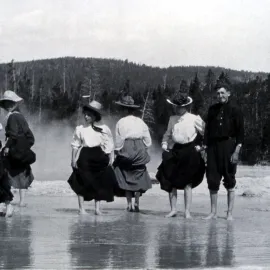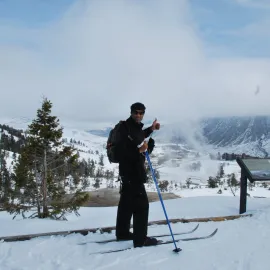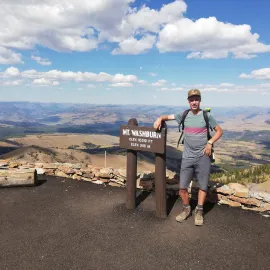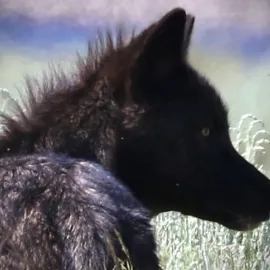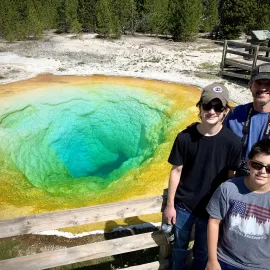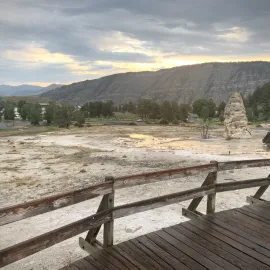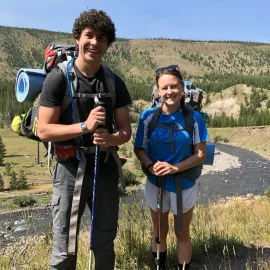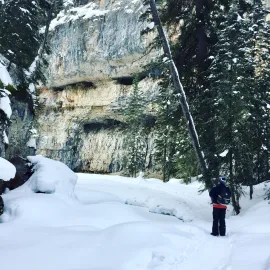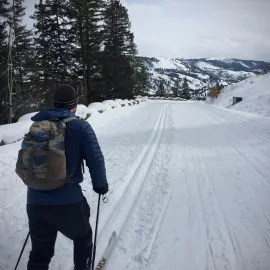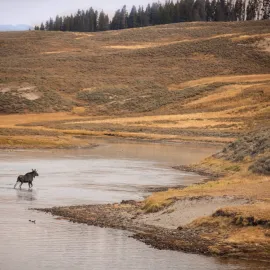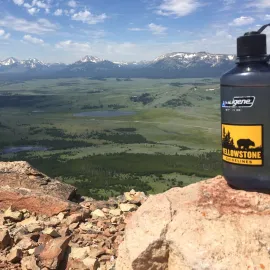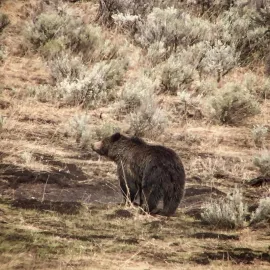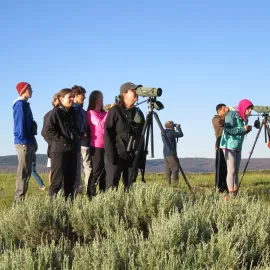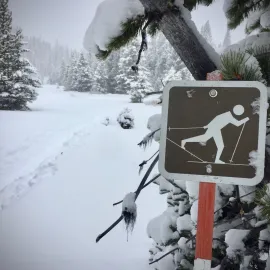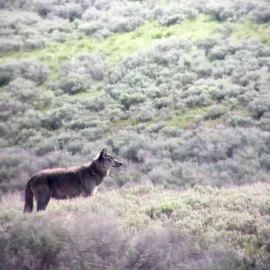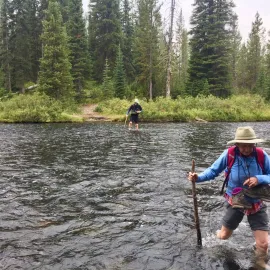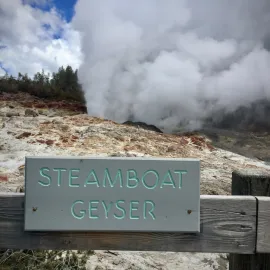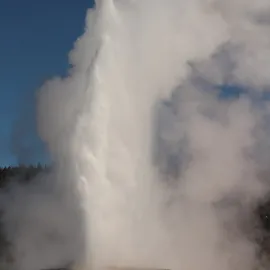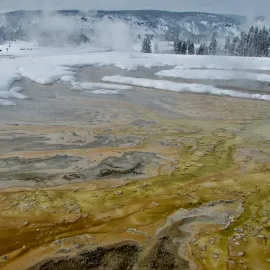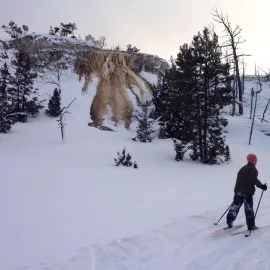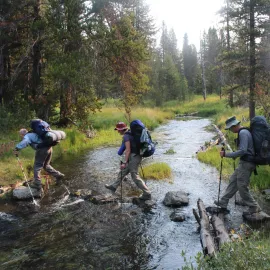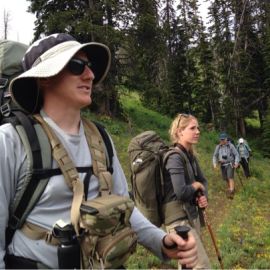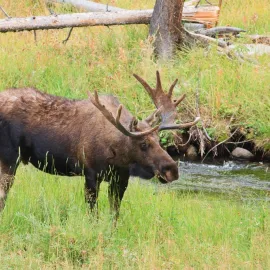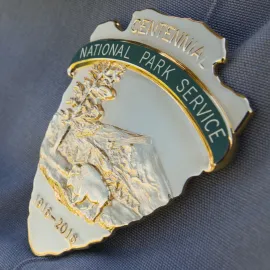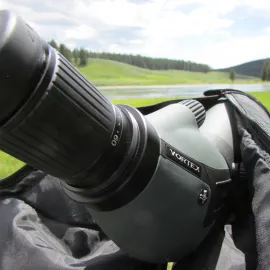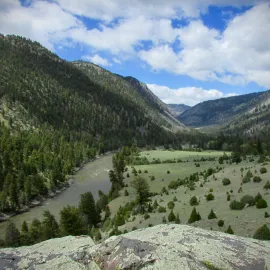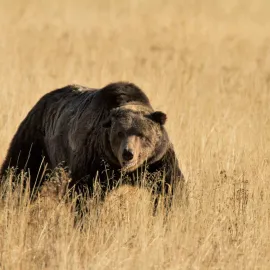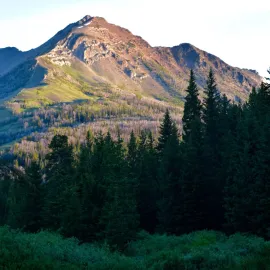Don't Miss Yellowstone's Smaller
When was the last time you had a Three Dog Day?
Wolves get all the press and attention in Yellowstone. Wolves this, wolves that. Wolf watchers, wolf tourism, wolf project, wolf safaris, etc. But what about the OTHER canines?
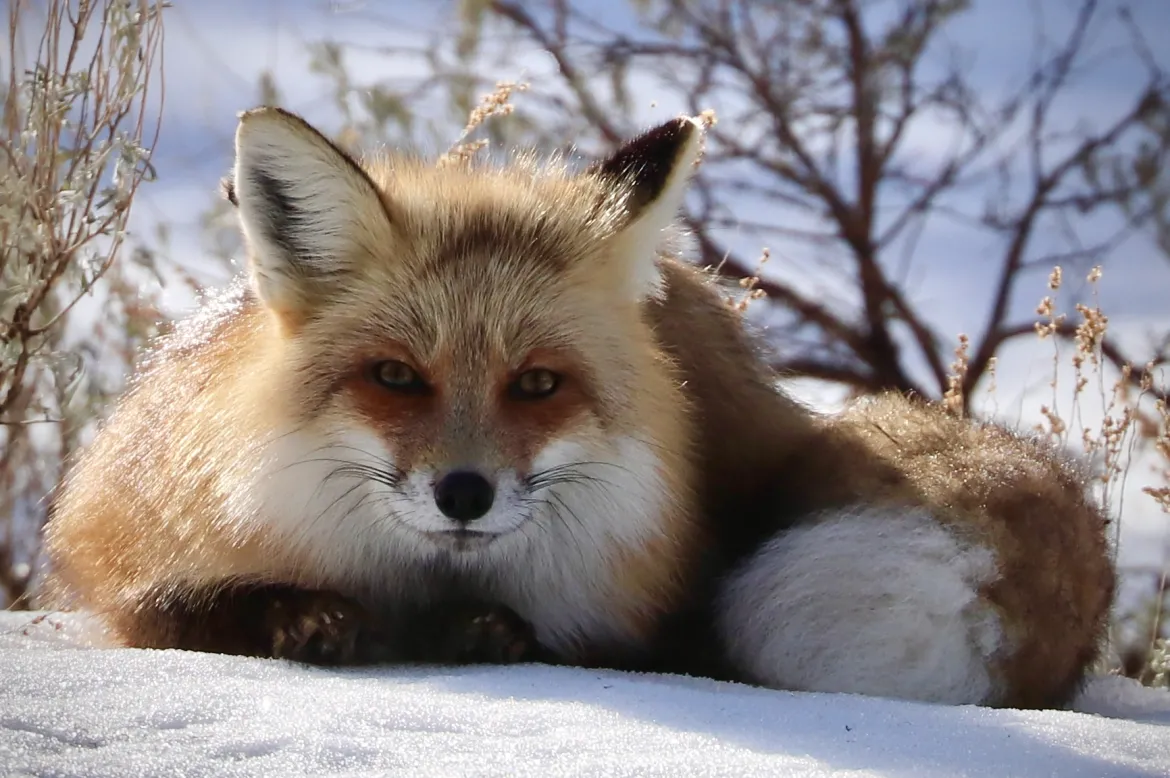
I’m not talking domestic dogs here. Fido is limited to leashes and parking lots in the Park. Not so for the red fox and the coyote.
Coyotes and foxes are part of the dog family. They inhabit similar terrain – basically all meadows and some of Yellowstone’s forests – but foxes are more elusive and smaller. Coyotes are the most frequently seen of Yellowstone’s canines, and may be found alone, in pairs or in small groups. Look for coyotes and foxes in Lamar Valley, Hayden Valley, Slough Creek, Little America, Blacktail Plateau, Fountain Flat or along the shores of Yellowstone Lake. If you find one, plan to watch for a while as they are always up to something. They are easier to see in winter due to contrast with the snow.
Coyotes are the most vocal of Yellowstone’s canines, emitting high pitched howls and yips. They can bark and yelp too. One of their nicknames is song dog. They are also known as brush wolves. Foxes bark too, and can make some creepy screaming sounds at night that will give you the chills. Both species are frequently nocturnal but may be seen out in the daylight too.
BOOK A TOUR
It’s common for folks to mistake a coyote for a wolf. We’ve all done it. But they are smaller – ½ to 1/3 as big as a wolf – usually reddish (wolves are mostly gray and black) with shorter legs and a pointed snout. Ears are bigger in proportion to the head, and the coyote often hangs its tail down whereas wolves usually walk with tail straight out.
Take a wildlife tour with Yellowstone Guidelines for a great chance to see and learn more about foxes and coyotes. We might even have a three dog day!
Yellowstone coyotes and foxes behave differently than most because we do not hunt or harass them. So a fox may walk right past you and ignore you. Coyotes are a bit more skittish but also can be aggressive, especially if they have been fed. Coyotes have bitten a number of people in Yellowstone (wolves never have). Some coyotes will approach people and even steal food from your hand, so keep your distance.
Top Dog No Longer in Yellowstone
Coyotes evolved in North America alongside dire wolves, 2 million years ago. For nearly 70 years the coyote (Canis latrans) was Yellowstone’s top dog. Wolves were exterminated from Yellowstone by 1927, giving these medium sized carnivores the run of the place. With the return of the wolf in 1995 coyotes underwent a steep learning curve as they were forced to adapt to their larger cousins who will often kill them.
Coyotes, along with ravens, have important roles in Native American origin stories as tricksters and creators. Familiar to cartoon watchers from the 70s as Wile E. Coyote, they are generalists and scavengers that can make a living nearly anywhere. Wile E. is highly intelligent and adaptable, but fortunately they do not actually employ dynamite. Coyotes do appear to be nearly indestructible. When the range of wolves shrank to nearly nothing, coyotes were there to fill the void. They likely live in every state except Hawaii, and have actually expanded their range in recent years. Eastern coyotes are interbreeding with dogs and wolves to make a “super-coyote.”
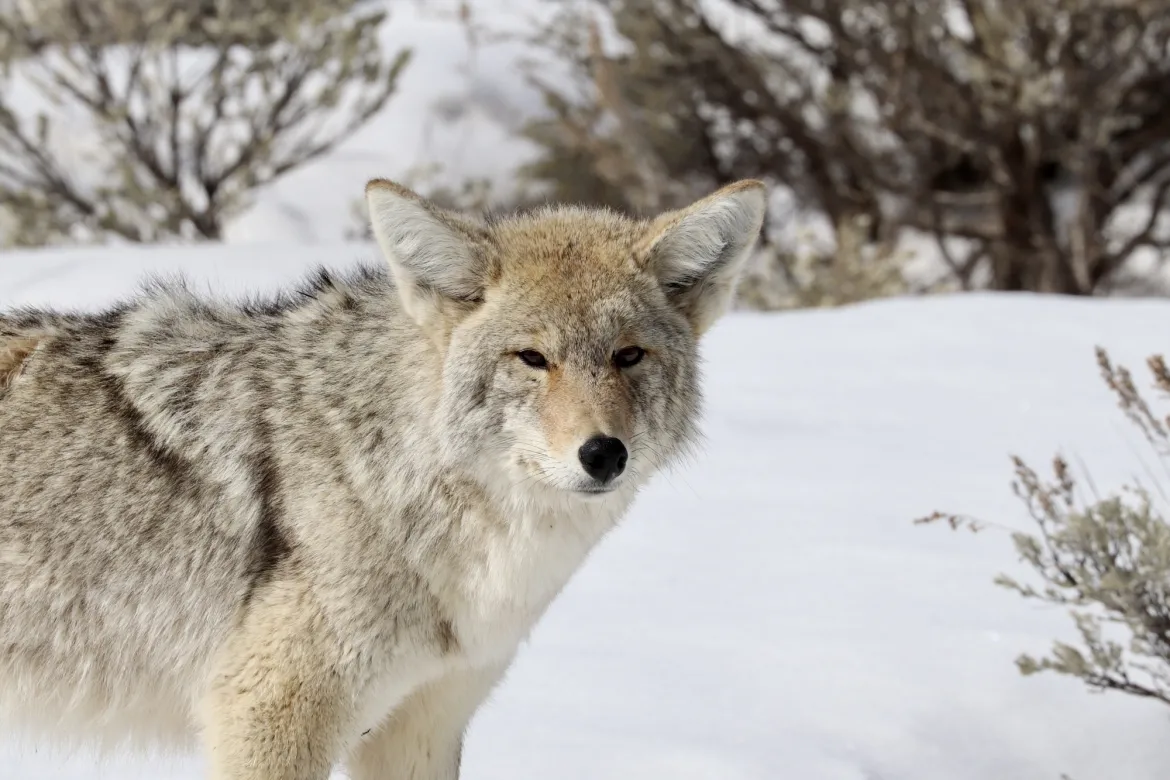
Coyotes have been persecuted since Europeans descended on North America but there may be more of these plucky canines than ever. They have famously turned up in downtown LA and in Central Park in New York City. Many states, especially in the West, have open season on coyotes where they are classified as “varmints” and hunted and trapped year round. But when you kill adult coyotes, the survivors often just have more pups since there is more food to go around.
Coyotes are large enough to take down sizeable prey like deer, pronghorn and young elk, and will even try a baby bison or a bighorn sheep some times. When wolves make a kill coyotes often lurk nearby, waiting for a chance to scurry in and grab a piece of meat. It’s a dangerous business for them. If no wolves or bears a present, coyotes may dominate a bison or elk carcass, where their antics are very entertaining. They hunch their backs and bare their teeth, snarling and yapping at one another and trying to chase off flocks of hungry ravens. They will at times gang up on other coyotes and kill each other in turf wars, just like wolves.
Coyotes and wolves are mortal enemies and wolves will kill them when they get the chance. But don’t count out the crafty coyote. Last year I watched two coyotes run a wolf off, then chase it a mile across Lamar Valley. They got ahold of the wolf and injured it and chased it into the forest. I have also seen a very determined coyote chase off a grizzly bear!
The Fabulous Mr. Fox
Known as an incorrigible raider of henhouses, the red fox is the most widespread of North America’s five species of fox, and the only one is found in Yellowstone – the red fox, Vulpes vulpes. Beautiful slender creatures, they can be seen hunting in meadows and forests throughout Yellowstone, especially on the Northern Range. Look for the white tip on the tail to distinguish it from coyotes. Yellowstone’s foxes may display a variety of beautiful color phases such as black, orange and white mixed. Red foxes do not turn white in winter like arctic foxes but they do grow a much thicker coat of fur. When these fluffy foxes curl up in the snow they use their long bushy tail as a scarf, covering their noses.
While wolves will usually ignore foxes, coyotes will kill them. So in a way the wolf is a friend to the fox since it kills coyotes.
The origin of red foxes in Yellowstone – most likely from Europe – is complicated and debatable. The familiar ones were probably brought to North America long ago to raise for their fur and either escaped or were set loose and went native. However we do have some fascinating native alpine subspecies of red fox that are ice age relics found in the high mountains of the Rockies, Sierras and Cascades. These have probably interbred with non-native foxes, making the origins hard to trace.
The Beartooth Mountains, close to Yellowstone’s Northeast Entrance, have a thriving population of native alpine red fox. You may even see them around Cooke City where some have become habituated to hand outs and even go into the bakery for treats! Biologists describe these alpine foxes as having a more “earthy” coloration, larger hairier paws and smaller ears than their familiar red brethren. Biologists recently discovered that, just like bears and birds and squirrels, these alpine foxes – which may have lived here for a half million years – eat the nutritious nuts of Whitepark pine, an endangered tree found at high elevations.
Winter hunting techniques
In winter, when the snow piles up, the primary prey for both foxes and coyotes are mice and voles, rodents that generally stay hidden under the white insulation. Both canine species will creep along the surface of the snow as silently as possible, listening for scurrying rodents below. When they pinpoint their prey they make spectacular leaps, diving into the snow to snag the hapless rodents.
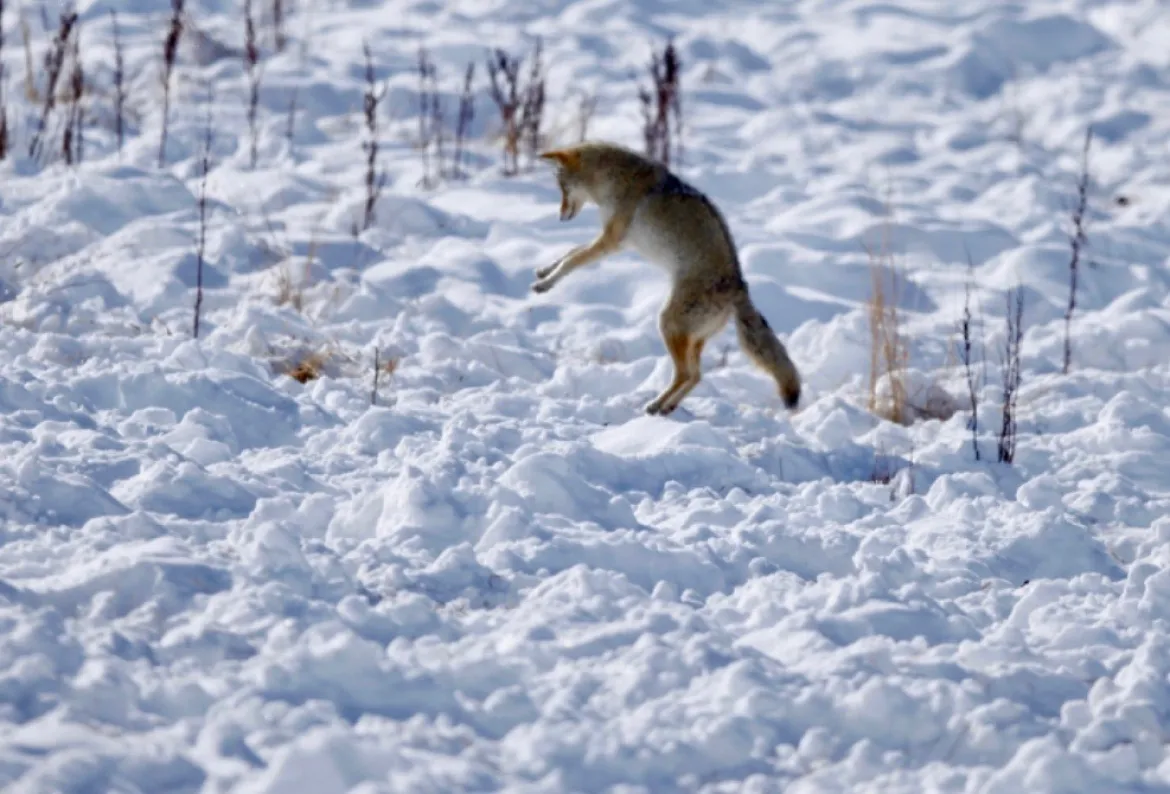
Coyotes will pounce with their paws and try to pin down a mouse then grab it with its mouth. Foxes make an even more spectacular arcing leap and dive face-first into the snow to bite their prey, legs and tail and rear exposed, then pull it up, kill it with a bite and swallow it. Foxes also have some special abilities – biologists say the can utilize their Earth’s magnetic field to triangulate on their prey, and almost always leap in the same direction. If you watch them as they hunt, they tip their head back and forth – a very endearing behavior – as they triangulate where to find dinner.
Foxes and coyotes will also hunt ground squirrels, tree squirrels, rabbits, hares, weasels, ducks, grouse, geese and other birds. Coyotes are able to catch fish some times when trout are spawning in shallow creeks. They also steal fish from river otters. Coyotes will walk on frozen rivers looking for fish remnants and have even been known to catch swans sleeping on the ice.
You can find these smaller dogs any time of year in Yellowstone. Coyotes are the most abundant and can be seen mousing in meadows in spring and summer, pouncing and wagging their tails. If you are real lucky you’ll get to see a den of fox or coyote pups – always in the spring – with little furballs wrestling and pouncing on each other. They can have up to 8 pups per den, and the adults take turns hunting for food to bring the hungry pups. Breeding happens in February and March and gestation is only two months.
So who eats foxes and coyotes? Wolves do kill coyotes but rarely eat them. They will however prey on pups of either species. Any larger predator, including bobcats, mountain lions, eagles and owls, will take a fox pup or two. Badgers will raid and eat an entire den of fox pups if they can. Strangely enough, coyotes and badgers also have been known to form a partnership. I have seen them hunting together, an odd couple to be sure, patrolling meadows full of ground squirrel burrows. One or the other – usually the badger – will start digging out a squirrel from its burrow. The squirrel may get caught or try to escape out another entrance. In that case either badger or coyote will be waiting to make the catch. And no they do not share the squirrel!
As you explore Yellowstone look and listen for these wily canines. Watch for their distinctive tracks in the snow. See how they interact with other species. Observe them, conserve them and enjoy the smaller dogs of Yellowstone.
Blog post by Phil Knight. Phil Knight is Bozeman local, author, outdoor enthusiast, and guide for Yellowstone Guidelines. For tours and adventures in Yellowstone with Phil, contact us at 406-599-2960 or tours@yellowstoneguidelines.com
Book A Trip in Yellowstone Guidelines
